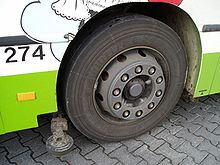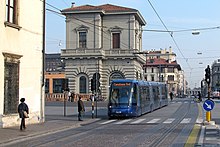Guided bus



Guided buses are buses steered for part or all of their route by external means, usually on a dedicated track. This track, which often parallels existing roads, excludes other traffic, permitting the maintenance of reliable schedules on heavily used corridors even during rush hours.
Guidance systems can be either physical, such as kerbs, or remote, such as optical or radio guidance.
On kerb-guided buses (often abbreviated to KGB) small guide wheels are attached to the bus which engage vertical kerbs on either side of the guideway. These guidewheels push the steering mechanism of the bus from side-to-side, keeping the bus centralised on the track. Away from the guideway, the bus is steered in the normal way. The start of the guideway is funnelled from a wide track to the normal width. This system permits high-speed operation on a narrow guideway as well as precise positioning at boarding platforms, facilitating access for the elderly and disabled. It is also possible to get electrical propulsion, sometimes called rubber-tyred trams.
History
Only a few examples currently exist, but more are proposed in various countries.
The first guided busway in the United Kingdom was in Birmingham, branded as Tracline 65, and had a short 1,968 feet (600 m) length as an experiment in 1984. It has since been removed.[1] A number of guided busways have since been planned or built in the United Kingdom. In Mannheim, Germany, from May 1992 to September 2005 a guided busway shared the tram alignment for a few hundred metres, which allowed buses to avoid a congested stretch of road in a location where there was no space for an extra traffic lane. It was discontinued as the majority of buses fitted with guide wheels were withdrawn for age reasons. There are no plans to convert newer buses.[citation needed]
The Cambridgeshire Guided Busway between Cambridge and St Ives is the world's longest guided busway.[2]
The Nagoya Guideway Bus in Nagoya, opened in March 2001 and is the only guided bus line in Japan.[citation needed]
The KGB guidance mechanism is a direct development of the early flangeways, predating even the railways. The Gloucester and Cheltenham Tramroad[3] of 1809 therefore has a claim to be the earliest guided busway. Earlier flangeways existed, but were not for passenger carrying.[4][5]
Rubber-tyred "trams"


A further development of the guided bus is the "tramway on tyres", in which a rubber-tyred vehicle is guided by a fixed rail in the ground and draws current from overhead electric wires like a conventional tram. Two incompatible systems exist, the Guided Light Transit (GLT) designed by Bombardier Transportation, and the Translohr system. There are no guide bars on the sides but there is a central guidance rail that, in the case of Translohr, is a special rail that is grasped by a pair of metal guide wheels set at 45° to the road and at 90° to each other. In the Bombardier system, a single double-flanged wheel between the rubber tyres follows the guidance rail. In both cases, the weight of the vehicle is borne by rubber tyres on bogies to which the guide wheels are attached. Power is supplied by overhead lines or by rechargeable batteries in areas where there are no overhead wires.


The Bombardier system has been adopted in Nancy and Caen, France, while the Translohr system is in use in Clermont-Ferrand, France and Tianjin and Shanghai, China, and is under construction in Padua, L'Aquila, and the mainland Mestre district of Venice in Italy. The Translohr system is intended for guidance-only operation, while with the Bombardier system the vehicles can be driven as normal buses as requirements dictate, such as journeys to the depot. The Bombardier vehicles are legally considered buses, and must bear bus-like rear-view mirrors, lights and number plates. Unlike trams, GLT vehicles have a steering wheel, though it is not used when following the guidance rail. Because the Translohr "tram" cannot move without guidance it will probably not be classified as a bus. Hence the Translohr vehicles on test runs on the Clermont-Ferrand network are not equipped with license plates.
These systems offer a much more tram-like experience than a regular guided bus, and offer some advantages over trams, such as a potentially smaller turning radius, the ability to climb steeper gradients (up to 13%), and quieter running around corners.[citation needed] The infrastructure installation can be less complicated than the installation of a complete tram line in an existing street.[citation needed] These systems have been likened to the tram equivalent of rubber-tyred metros, and they are also correspondingly less efficient than steel-wheeled light rail vehicles. There is no evidence to prove the superiority of either guidance system. Both Bombardier Guided Light Transit and Translohr have encountered derailment during operation.[6][7]
Other experimental bus systems have non-mechanical guidance systems, such as sensors or magnets buried in the roadway.[8][9] In 2004, Stagecoach Group signed a deal with Siemens AG to develop an optical guidance system for use in the UK.[10]
A further increase in capacity from rubber-tyred trams is rubber-tyred metro. Such systems are in operation in a number of cities, notably some of the lines of the Paris Métro: the system originated in France.
Guidance systems
Optical guidance

Optical guidance relies on the principles of image processing. A camera in the front of the vehicle scans the bands of paint on the ground representing the reference trajectory. The signals obtained by the camera are sent to an onboard computer which combines them with dynamic parameters of the vehicle (speed, yaw rate, wheel angle). The calculator transmits commands to the guidance motor located on the steering column of the vehicle to control its trajectory in line with that of the reference.
Optical guidance is a means of reaching light rail performance with a fast and economical set-up. It enables buses to have precision-docking capabilities as efficient as those of a light rail system and reduces dwell times. Moreover, optical guidance makes it possible to drive the vehicle to a precise point on a platform according to an accurate and reliable trajectory. The distance between the door steps and the platform is optimized not to exceed 5 centimetres (2.0 in). Access to the vehicle at foot-level is then possible, and there is no need to use a mobile ramp for people with mobility impairments.
The OPTIGUIDE system, an optical guidance device developed by Siemens Transportation Systems SAS, has been in revenue service since 2001 on the bus transit system of Rouen, France. OPTIGUIDE has also been fitted on trolleybuses in Castellon (Spain) since June 2008 and there are plans for it to be used on systems in Nîmes (France) and Bologna (Italy).
Magnetic guidance
Magnetic guidance relies on magnets buried in the roadway.
Two buslines in Eindhoven, Netherlands are used by Phileas vehicles, a combination of tram and bus. Line 401 from Eindhoven central station to Eindhoven Airport is 9 km long, consists largely of concrete free bus lanes and has about 30 Phileas stop platforms. Line 402 from Eindhoven central station to Veldhoven branches off from line 401 and adds another 6 km of free bus lanes and about 13 stops.[11] The regional authority for urban transport in the region Eindhoven (SRE) decided not to use the magnetic guidance system any more for some years.
The Douai region, France is developing a public transport network with dedicated infrastructure. The total length of the lines will be 34km (21 miles). The first stage is a line of 12 km from Douai via Guesnain to Lewarde, passing close to Waziers, Sin-le-Noble, Dechy and Lambres-lez-Douai. 39 stop platforms will be provided with an average distance between the stops of 400 m. A number of stops will be placed at the right side of each lane. Central stops between both lanes will be placed at locations with limited space at the right side. This requires vehicle to have doors on both sides.
On November 3, 2005 a licence and technology transfer agreement was signed between Advanced Public Transport Systems (APTS) and the Korea Railroad Research Institute (KRRI). KRRI develops the Korean version of Phileas vehicle by May 2011.[12]
Examples of guided busways
- Bradford (A641 road Manchester Road Quality Bus Initiative)
- Cambridgeshire Guided Busway, England – Huntingdon to Trumpington[13]
- Crawley Fastway
- Edinburgh (West Edinburgh Busways (WEBS) "Fastlink" – Stenhouse to Broomhouse); to be replaced by Edinburgh Trams
- Ipswich (Kesgrave)
- Leeds (A61 Scott Hall Road)
- Leeds (A64 York Road and A63 Selby Road) – The East Leeds Quality Bus Initiative "Elite"
- Essen, Germany
- Mannheim, Germany
- O-Bahn Busway, Adelaide, Australia
- Yutorīto Line, Nagoya, Japan. In Japan, the bus is legally considered as a sort of railway.
Tram-like guided busways include:
- Bombardier Guided Light Transit – Caen, France; Nancy, France
- Translohr – Clermont-Ferrand, France; Tianjin, China; Shanghai, China; Padua, Italy; Istanbul, Turkey
- Phileas – Eindhoven, Netherlands; Douai, France
See also
References
- ^ "The former Birmingham (UK) Tracline 65 Kerb Guided Busway". Citytransport.info. Retrieved May 21, 2010.
- ^ "Cambridgeshire guided busway opens to passengers". BBC News. August 7, 2011.
- ^ Bick, D. E. (1968). The Gloucester and Cheltenham Railway and the Leckhampton Quarry Tramroads. Oakwood Press.
- ^ Schofield, R. B. Benjamin Outram 1764–1805: an engineering biography. Cardiff: Merton Priory. ISBN 1-898937-42-7.
- ^ Wagonway Research Circle. "Plateways/tramways – overview and list of some available resources". Island Publishing. Retrieved August 8, 2011.
- ^ "Further problems in Nancy". LRTA. November 20, 2002.
- ^ "The first modern guided tramway in China derails (国内首条现代导轨电车出轨[[Category:Articles containing Chinese-language text]])" (in Chinese). news.qq.com. August 20, 2007.
{{cite news}}: URL–wikilink conflict (help) - ^ Simon Smiler. "New Era Hi-tech Buses". citytransport.info. Retrieved May 21, 2010.
- ^ "University of Berkley PATH Magnetic Guidance System – used on Snowploughs with trials including Transit Bus running and docking". Path.berkeley.edu. Retrieved May 21, 2010.
- ^ "Stagecoach signs deal with Siemens to develop new bus optical guidance system". Stagecoach Group. December 8, 2004.
- ^ APTS Phileas
- ^ "Bimodal Transportation Research Center(Korea)". Bimodaltram.com. Retrieved May 21, 2010.
- ^ "Cambridgeshire County Council – Guided Busway homepage". Cambridgeshire.gov.uk. Retrieved January 24, 2011.
External links
- Guided bus information and pictures
- Adelaide O-Bahn
- First Group guided busways
- Translohr official site
- Guided Light Transit official web site
- Cambridgeshire County Council's Guided Busway project
- "An Update on Curb Guided Bus Technology and Deployment Trends", Journal of Public transport 2006 BRT Special Edition (PDF 964Kb)
- University of Minnesota's ITS Institute "BRT Technologies: Assisting Drivers Operating Buses on Road Shoulders"

